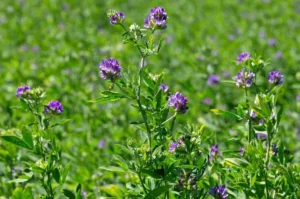Licorice Root

Licorice Root is a perennial herb renowned for its sweet flavor and numerous health benefits. It has been used in traditional medicine for centuries and is valued for its soothing and healing properties. The herb is often used in both culinary and medicinal applications and is known for its distinctive taste and therapeutic effects.
1. Size:
- Licorice Root typically grows to a height of 3 to 4 feet (90 to 120 cm) with a spread of about 2 feet (60 cm), forming a bushy, herbaceous plant.
2. Color:
- The root has a light brown to tan color and is often used in dried form.
- The plant’s stems are green, and the leaves are a light, grayish-green.
3. Texture:
- The root is fibrous and woody, with a rough surface.
- The leaves are pinnate, with a smooth texture, and the overall plant has a slightly coarse feel.
4. Fragrance:
- Licorice Root has a distinctive, sweet, and slightly earthy aroma, which becomes more pronounced when the root is chewed or used in extracts.
- The scent is reminiscent of anise or fennel, with a strong, sweet undertone.
5. Uses:
- Licorice Root is commonly used in herbal medicine to soothe gastrointestinal issues, including indigestion, heartburn, and stomach ulcers.
- It is also used to alleviate respiratory conditions such as coughs and bronchitis due to its expectorant properties.
- The root is added to various culinary dishes and confections for its sweet flavor and is used in teas and tinctures for its health benefits.
6. Habitat:
- Licorice Root thrives in well-drained soil with full sun to partial shade. It is commonly found in temperate regions of Europe and Asia.
- It is cultivated in gardens and herb beds, particularly in areas with a mild climate.
7. Cultural Significance:
- In traditional medicine, Licorice Root has been used for its soothing and anti-inflammatory properties. It is an important herb in Chinese and Ayurvedic medicine.
- The herb is also used in various cultural practices for its perceived benefits in balancing digestive health and enhancing overall well-being.
Spiritual Properties
- Cleansing and Purification: Licorice Root is often used in spiritual practices for its perceived ability to cleanse and purify the mind and body. It is believed to bring about emotional balance and clarity.
- Healing and Harmony: The herb is thought to aid in emotional healing and restoring harmony within oneself. It is used in rituals and meditation to promote inner peace and overall well-being.
Medicinal Properties
- Digestive Health: Licorice Root is renowned for its ability to soothe gastrointestinal issues, including indigestion, heartburn, and stomach ulcers. It is commonly used in teas and supplements to support digestive health.
- Anti-inflammatory: The herb has anti-inflammatory properties that can help reduce inflammation and pain associated with conditions such as arthritis.
- Respiratory Health: Licorice Root is used to alleviate respiratory conditions like coughs and bronchitis due to its expectorant and soothing properties.
- Immune Support: It has natural antimicrobial properties that may help support the immune system and fight infections.
Adverse Actions & Side Effects
- Sensitivity Reactions: Some individuals may experience allergic reactions or sensitivities when using Licorice Root, especially in high doses or concentrated forms.
- Interaction with Medications: Licorice Root may interact with certain medications, particularly those affecting blood pressure or electrolyte balance. It is important to consult with a healthcare provider before using it alongside medications.
Side Effects:
- High Blood Pressure: Prolonged use of Licorice Root or consuming it in large quantities can lead to elevated blood pressure or fluid retention.
- Headaches: Excessive use of Licorice Root may cause headaches or dizziness in some individuals.
- Gastrointestinal Issues: High doses of Licorice Root can cause gastrointestinal discomfort, including nausea or abdominal pain.

Healing Herbal Pesto
Healing Herbal Pesto This healing herbal pesto is packed with both flavor and spiritual healing properties. It’s a versatile sauce that can be used on

Alfalfa Leaves
Alfalfa Leaves Alfalfa is a perennial flowering plant from the legume family, known for its high nutrient content. It is widely cultivated as a forage

Dandelion Root
Dandelion Root Dandelion Root, derived from the Taraxacum officinale plant, is a well-known herb in traditional medicine and herbal remedies. While often regarded as a

Papaya Leaf
Papaya Leaf Papaya Leaf (Carica papaya) comes from the tropical fruit tree known for its large, deeply lobed leaves. While the fruit of the papaya

Yellow Dock
Yellow Dock Yellow Dock, scientifically known as Rumex crispus, is a perennial herb known for its distinctive long, curly leaves and deep yellow root. It

Himalayan Pink Salt
Himalayan Pink Salt Himalayan pink salt is renowned for its distinct and attractive appearance. Typically found in large crystals or fine granules, it displays a